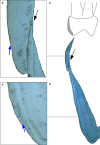Enamel biorhythms of humans and great apes: the Havers-Halberg Oscillation hypothesis reconsidered
- PMID: 27726135
- PMCID: PMC5244461
- DOI: 10.1111/joa.12551
Enamel biorhythms of humans and great apes: the Havers-Halberg Oscillation hypothesis reconsidered
Abstract
The Havers-Halberg Oscillation (HHO) hypothesis links evidence for the timing of a biorhythm retained in permanent tooth enamel (Retzius periodicity) to adult body mass and life history traits across mammals. Potentially, these links provide a way to access life history of fossil species from teeth. Recently we assessed intra-specific predictions of the HHO on human children. We reported Retzius periodicity (RP) corresponded with enamel thickness, and cusp formation time, when calculated from isolated deciduous teeth. We proposed the biorhythm might not remain constant within an individual. Here, we test our findings. RP is compared between deciduous second and permanent first molars within the maxillae of four human children. Following this, we report the first RPs for deciduous teeth from modern great apes (n = 4), and compare these with new data for permanent teeth (n = 18) from these species, as well as with previously published values. We also explore RP in teeth that retain hypoplastic defects. Results show RP changed within the maxilla of each child, from thinner to thicker enameled molars, and from one side of a hypoplastic defect to the other. When considered alongside correlations between RP and cusp formation time, these observations provide further evidence that RP is associated with enamel growth processes and does not always remain constant within an individual. RP of 5 days for great ape deciduous teeth lay below the lowermost range of those from permanent teeth of modern orangutan and gorilla, and within the lowermost range of RPs from chimpanzee permanent teeth. Our data suggest associations between RP and enamel growth processes of humans might extend to great apes. These findings provide a new framework from which to develop the HHO hypothesis, which can incorporate enamel growth along with other physiological systems. Applications of the HHO to fossil teeth should avoid transferring RP between deciduous and permanent enamel, or including hypoplastic teeth.
Keywords: Retzius lines; biorhythms; enamel growth; life history.
© 2016 Anatomical Society.
Figures



References
-
- Aiello LC, Dean MC, Montgomery C (1991) The natural history of deciduous tooth attrition in hominoids. J Hum Evol 21, 397–412.
-
- Batina N, Renugopalakrishnan V, Casillas Lavin PN, et al. (2004) Ultrastructure of dental enamel afflicted with hypoplasia: an a atomic force microscopic study. Calcif Tissue Int 74, 294–301. - PubMed
-
- Berdal A, Bailleul‐Forestier I, Davideau J‐L, et al. (2005) Dento‐alveolar bone complex and vitamin D In: Vitamin D (eds Feldman D, Pike JW, Glorieux FH.), pp. 599–607. San Diego: Elsevier Academic Press.
-
- Beynon AD, Dean MC, Reid DJ (1991a) Histological study on the chronology of the developing dentition in Gorilla and Orangutan. Am J Phys Anth 86, 189–203.
-
- Beynon AD, Dean MC, Reid DJ (1991b) On thick and thin enamel in hominoids. Am J Phys Athropol 86, 295–309.
MeSH terms
LinkOut - more resources
Full Text Sources
Other Literature Sources
Research Materials
Miscellaneous

